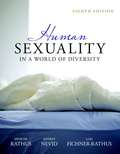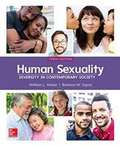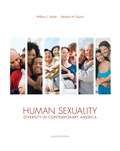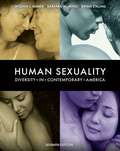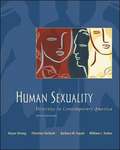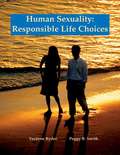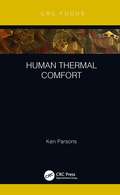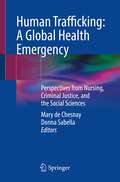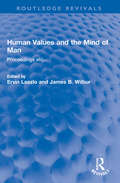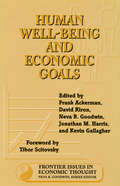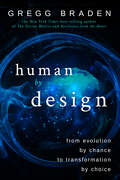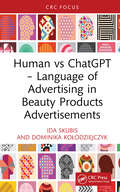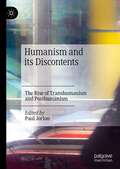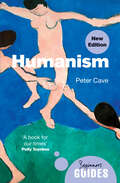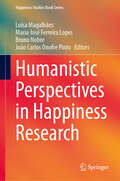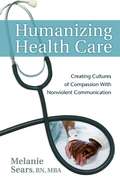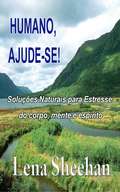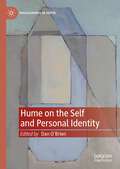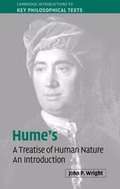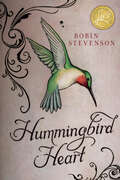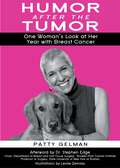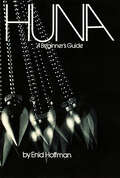- Table View
- List View
Human Sexuality in a World of Diversity (8th Edition)
by Lois Fichner-Rathus Jeffrey S. Nevid Spencer A. RathusHuman Sexuality in a World of Diversity, 8e examines the rich diversity found in human sexuality and helps students develop their own opinions by promoting critical thinking skills, personal sexual health awareness, and responsible decision-making. Firmly rooted in science, the text systematically encourages students to apply the research to their own lives.
Human Sexuality in a World of Diversity (Ninth Edition)
by Lois Fichner-Rathus Spencer A. Rathus Jeffrey S NevidHuman Sexuality in a World of Diversity, 9/e examines the rich diversity found in human sexuality. More significantly, the text places an emphasis on cultivating understanding in a world of increasing diversity through personal engagement. Students are encouraged to reflect upon their own beliefs and experiences throughout the text in order to foster a more personal and impactful learning experience. The text also helps students develop their own opinions by promoting critical thinking skills, personal sexual health awareness, and responsible decision-making.
Human Sexuality in a World of Diversity 5th ed.
by Lois Fichner-Rathus Jeffrey S. Nevid Spencer A. RathusDetailed discussion of human sexuality.
Human Sexuality: Diversity In Contemporary Society
by Barbara W. Sayad William L YarberHuman Sexuality: Diversity in Contemporary Society continues to be a pioneering text in many ways. The sexual affirmation approach encourages students to become proactive in and about their own sexual well-being and includes an emphasis on the importance of embracing intimacy, pleasuring, and mutual satisfaction in sexual expression. It also strives to represent the contemporary, diverse society that students encounter inside and outside the classroom. <P><p>And with McGraw-Hill Education Connect for Human Sexuality, students embark on a personalized digital learning program, which allows them to study more effectively and efficiently. Each chapter contains multiple Think About It features that prompt students to think critically about topics in sexuality such as am I normal, the science of love, hooking up, what behaviors constitute having had sex, orgasm and pleasure, and how college students indicate and interpret consent to have sex. The Practically Speaking feature asks students to examine their own values and the ways they express their sexuality. Topics include sexual communication, effective condom use, having sex again after sexual assault, and a glossary on sex, gender, and gender variation terms. These features help students apply the concepts presented in the book to their own lives.
Human Sexuality: Diversity in Contemporary America (8th Edition)
by Bryan Strong William Yarber Barbara SayadHuman Sexuality: Diversity in Contemporary America presents a forward thinking, open approach to Human Sexuality for today's student. The new lead authors, Bill Yarber and Barbara Sayad, continue to bring their research experience to the book while maintaining the engaging writing style that original author Bryan Strong brought to this best-selling text for years. The first text to achieve a full integration of cutting-edge research with a contemporary "sex-positive" approach, it also strives to represent the modern, diverse world that students encounter outside the classroom. Both within the text itself and throughout the exemplary art and photo program, the focus is on inclusion. Human Sexuality has been lauded by students and instructors alike for providing the most integrated and non-judgmental view of sexual orientation available. The eighth edition maintains these themes while adding a new contemporary design, streamlined format and significant content and feature revisions and updates.
Human Sexuality: Diversity in Contemporary America (Seventh Edition)
by Bryan Strong William L. Yarber Barbara J. SayadHuman Sexuality: Diversity in Contemporary America presents a forward thinking, open approach to Human Sexuality for today's student. The new lead authors, Bill Yarber and Barbara Sayad, continue to bring their research experience to the book while maintaining the engaging writing style that original author Bryan Strong brought to this best-selling text for years. The first text to achieve a full integration of cutting-edge research with a contemporary"sex-positive"approach, it also strives to represent the modern, diverse world that students encounter outside the classroom. Both within the text itself and throughout the exemplary art and photo program, the focus is on inclusion. Human Sexuality has been lauded by students and instructors alike for providing the most integrated and non-judgmental view of sexual orientation available. The seventh edition maintains these themes while adding a new contemporary design, streamlined format and significant content and feature revisions and updates.
Human Sexuality: Diversity in Contemporary America 5th ed.
by Bryan Strong Christine Devault Barbara W. Sayad William L. YarberA non-judgmental introduction to human sexuality that features integration of ethnic, cultural, gender, and sexual orientation differences and similarities.
Human Sexuality: Making Informed Decisions
by David Knox Caroline Schacht Mark A WhatleyProvides an understanding of the human reproductive system, the various factors that influence the sexual decisions that every individual make and guides us to making the right sexual decision putting into consideration all the outcomes/consequences of every option. The book lets us know we have a deliberate choice to make in a relationship, a healthy choice for both the body and mind.
Human Sexuality: Responsible Life Choices
by Verdene Ryder Peggy B. SmithProvides teenage readers with basic information about sexual development and reproductive health. Chapters explain the sexual decision-making process and examine the outcomes and risks of sexual activity. Annotation c. by Book News, Inc., Portland, OR.
Human Thermal Comfort
by Ken ParsonsThermal comfort is a desirable state familiar to all people. Providing inspirational indoor and outdoor environments that provide thermal comfort, in the context of energy use and climate change, is a challenge for the 21st century. This book provides an up-to-date, comprehensive coverage of thermal comfort from principles and theory to practical application. The book begins with current knowledge and understanding of thermal comfort and its application to providing thermal conditions for indoor and outdoor environments. It integrates and presents new ideas to provide a comprehensive model of thermal comfort so that we can move on from the 20th and early 21st century and provide a focus for developments for future decades. This book will be of interest to practitioners and students and anyone involved with fields such as environmental design, physiology, ergonomics, human factors, industrial hygiene, architecture, health and safety and air conditioning. • Provides current thermal comfort standards and regulations • Describes the PMV, PPD, ET* and SET thermal comfort indices • Discusses adaptive thermal comfort, adaptive opportunity and explains why we have not moved towards a more dynamic and interactive approach to providing thermal comfort • Presents a new model relating thermal discomfort to performance • Shows how to construct a computer model of thermal comfort • Offers how to conduct a thermal comfort survey Human Thermal Comfort provides new ideas for achieving thermal comfort for offices, vehicles, atriums, and plazas of the future.
Human Trafficking: Perspectives from Nursing, Criminal Justice, and the Social Sciences
by Donna Sabella Mary De ChesnayThis book presents various forms of human trafficking, a growing trend in the exploitation of large numbers of people with concurrent public health, socio-cultural, and economic costs to countries burdened with the consequences of the COVID-19 pandemic. Edited by psychiatric-mental health nurses and an applied anthropologist, this volume covers all forms of human trafficking: sex trafficking, forced labor, forced marriage, baby trafficking, organ trafficking, child marriage, and child soldiers with a global public health and policy focus. As such, it fills a gap in human trafficking knowledge and is built on courses springing up around the United States in multiple disciplines. Medical, mental health, and social work interventions are included as well as information about programs with documented outcomes. Each chapter includes state of the art of knowledge with case studies illustrating specific focal ideas, discussion, questions and exercises in order to help readers retain and reinforce chapter material. This textbook will be useful in the disciplines of nursing, medicine, public health, social work, and policy making, as well as in disciplines in which human trafficking is a current interest, such as law, criminal justice, and education.
Human Values and the Mind of Man: Proceedings etc... (Routledge Revivals)
by Ervin Laszlo James B. WilburFirst Published in 1971, Human Values and the Mind of Man examines how value questions have been treated in traditional theories of human nature. It discusses the following topics: theory of mind as seen through the rules of the generation of languages; the implications for human value of automata theory; the nervous system, higher mental processes and human values; value consequences of various positions on the mind-body problem; the implications of self-actualization theory for human value; and specific value problems in the philosophy of mind. The book presents an interdisciplinary dialogue centred around thoughts about man and their implications for human action, decision, and nature of what we call the ‘human mind’. This book is an essential read for philosophers, psychologists, scientists, and humanists.
Human Well-Being and Economic Goals (Frontier Issues in Economic Thought #3)
by Kevin Gallagher Jonathan Harris Neva R. Goodwin David Kiron Frank Ackerman Kenneth ArrowWhat are the ends of economic activity? According to neoclassical theory, efficient interaction of the profit-maximizing "ideal producer" and the utility-maximizing "ideal consumer" will eventually lead to some sort of social optimum. But is that social optimum the same as human well-being? Human Well-Being and Economic Goals addresses that issue, considering such questions as: *Does the maximization of individual welfare really lead to social welfare? *How can we deal with questions of relative welfare and of equity? *How do we define, or at least understand, individual and social welfare? *And how can these things be measured, or even assessed? Human Well-Being and Economic Goals brings together more than 75 concise summaries of the most significant literature in the field that consider issues of present and future individual and social welfare, national development, consumption, and equity. Like its predecessors in the Frontier Issues in Economic Thought series, it takes a multidisciplinary approach to economic concerns, examining their sociological, philosophical, and psychological aspects and implications as well as their economic underpinnings. Human Well-Being and Economic Goals provides a powerful introduction to the current and historical writings that examine the concept of human well-being in ways that can help us to set goals for economic activity and judge its success. It is a valuable summary and overview for students, economists, and social scientists concerned with these issues.
Human by Design: From Evolution by Chance to Transformation by Choice
by Gregg BradenHuman by Design invites you on a journey beyond Darwin’s theory of evolution, beginning with the fact that we exist as we do, even more empowered, and more connected with ourselves and the world, than scientists have believed possible.In one of the great ironies of the modern world, the science that was expected to solve life’s mysteries has done just the opposite. New discoveries have led to more unanswered questions, created deeper mysteries, and brought us to the brink of forbidden territory when it comes to explaining our origin and existence. These discoveries reveal the following facts: • Fact 1. Our origin —Modern humans appeared suddenly on earth approximately 200,000 years ago, with the advanced brain, nervous system, and capabilities that set them apart from all other known forms of life already developed, rather than having developed slowly and gradually over a long periods of time. • Fact 2. Missing physical evidence —The relationships shown on the conventional tree of human evolution are speculative connections only. While they are believed to exist, a 150-year search has failed to produce the physical evidence that confirms the relationships shown on the evolutionary family tree. • Fact 3. New DNA evidence —The comparison of DNA between ancient Neanderthals, previously thought to be our ancestors, and early humans tells us that we did not descend from the Neanderthals. • Fact 4. A rare DNA fusion —Advanced genome analysis reveals that the DNA that sets us apart from other primates, including in our advanced brain and nervous system, is the result of an ancient and precise fusion of genes occurring in a way that suggests something beyond evolution made our humanness possible. • Fact 5. Our extraordinary abilities —We are born with the capacity to self-heal, to self-regulate longevity, to activate an enhanced immune response, and to experience deep intuition, sympathy, empathy, and, ultimately, compassion —and to do each of these on demand.In this book, New York Times best-selling author and 2017 Templeton Award nominee Gregg Braden crosses the traditional boundaries of science and spirituality to answer the timeless question at the core of our existence —Who are we? —and to reveal science-based techniques that awaken our uniquely human experiences of deep intuition, precognition, advanced states of self-healing, and much more! Beyond any reasonable doubt, Human by Design reveals that we’re not what we’ve been told, and much more than we’ve ever imagined.
Human vs ChatGPT – Language of Advertising in Beauty Products Advertisements
by Ida Skubis Dominika KołodziejczykThis book systematically investigates the linguistic strategies employed in beauty product advertising to assess their persuasive and manipulative effects. The work is divided into two sections: a review of relevant literature and an empirical analysis of advertisements. The analysis initially focuses on the linguistic features of advertisements created by humans prior to the introduction of ChatGPT, examining the linguistic measures used and their methods of persuasion and manipulation. Subsequent sections provide a detailed examination of advertisements generated by ChatGPT versions 3.5 and 4.0, analysing the artificial intelligence’s use of linguistic techniques. This includes a meta-analysis where ChatGPT itself discusses the linguistic strategies it employs. The ultimate goal is to compare and contrast the effectiveness and linguistic devices used in advertisements crafted by humans and those by ChatGPT, analysing how AI influences the language of advertising and its impact on consumer behaviour.
Humanism and its Discontents: The Rise of Transhumanism and Posthumanism
by Paul JorionThis book explains that while posthumanism rose in opposition to the biblical contention that ‘Man was created in the image of God’, transhumanism ascertained the complementary view that ‘Man has been assigned dominion over all creatures’, further exploring a path that had been opened up by the Enlightenment’s notion of human perfectibility.It explains also how posthumanism and transhumanism relate to deconstruction theory, and on a broader level to capitalism, libertarianism, and the fight against human extinction which may involve trespassing the boundary of the skin, achieving individual immortality or dematerialization of the Self and colonisation of distant planets and stars.Two authors debate about truth and reason in today’s world, the notion of personhood and the legacy of the Nietzschean Superhuman in the current varieties of anti-humanism.
Humanism: A Beginner's Guide (updated edition) (Beginner's Guides)
by Peter CaveLife does not become empty and meaningless in a godless universe. This is the contention at the heart of humanism, the philosophy concerned with making sense of the world through reason, experience and shared human values. In this thought-provoking introduction, Peter Cave explores the humanist approach to religious belief, ethics and politics, and addresses key criticisms. Revised and updated to confront today&’s great crises – the climate emergency and global pandemics – and the future of humanism in the face of rapid technological advancement, this is for anyone wishing to better understand what it means to be human in the twenty-first century.
Humanistic Perspectives in Happiness Research (Happiness Studies Book Series)
by Luísa Magalhães Maria José Ferreira Lopes Bruno Nobre João Carlos Onofre PintoThis volume provides innovative perspectives on the scholarly connection between the humanities and happiness, and considers the narrative expressions of happiness and recent investigations about happiness, its metrics, and objective insights about human wellbeing. This volume relates intemporal humanistic values to views across social and behavioural sciences, and thereby covers a broad interdisciplinary frame, from philosophy, psychology, literary studies, to the communication sciences. The philosophers in this volume discuss the achievement of happiness through the cultivation of virtue, as well as the logic of the gift as an experience of personal fulfilment and the fact that happiness is inextricably linked to hope. Their chapters take on the approach of the permanent human struggle to generate global horizons of happiness and thus attain eternal bliss. Scholars from other fields of the humanities and communication sciences consider the positive messages of environmental happiness in virtual platforms, where the Homo digitalis finds happiness at the click of a button, often under the endorsement of celebrities, or under the visual fruition of playful objects. They also present the intertextual memory of happiness as a condition for humanistic research. Finally, this volume considers the sphere of education as the best place in which to apply the results of sustainable happiness measurement and research, and to realize this complementary, humanistic perspective on happiness research.
Humanizing Health Care: Creating Cultures of Compassion With Nonviolent Communication
by Melanie Sears RnThe tenets ofNonviolent Communicationare applied to a variety of settings, including the workplace, the classroom, and the home, in these booklets on how to resolve conflict peacefully. Illustrative exercises, sample stories, and role-playing activities offer the opportunity for self-evaluation, discovery, and application. Focusing on the language used in the health care system, this manual teaches health care administrators, nurses, physicians, and mental health practitioners how to create lasting, positive improvements to patient care and the workplace environment. Arguing that a crisis within health care is the inability of many professionals to relate to the personal, human dimension of their work, this reference teaches how to counteract the negativity that certain labels, diagnosis, judgments, and analyses can cause and shows how to better integrate a culture of compassion, empathy, and honesty. Readers will also learn an effective framework to reduce health care staff burnout and turnover, create a culture of mentorship and learning, compassionately diffuse "problem patients," and effectively address systemic barriers to care as they arise.
Humano, ajude-si: Soluções naturais para o estresse do corpo, mente e espírito
by Lena SheehanUm guia abrangente para o gerenciamento do estresse no corpo, mente e espírito, o Soluções naturais para o estresse do corpo, mente e espírito combina informações médicas tradicionais com holísticas, espirituais e metafísicas. Dentro deste livro, há informações valiosas para ajudá-lo a aprender a equilibrar todos os aspectos de sua vida. Agora você pode criar um ambiente e estilo de vida sem estresse, entendendo os efeitos que o estresse pode ter sobre seu corpo e quais alimentos, ervas, cristais e cores podem ajudar a aliviá-lo. Esse conhecimento, combinado com a meditação básica e as afirmações espirituais que são fornecidas para atuar como diretrizes, faz da Soluções naturais para o estresse do corpo, mente e espírito uma ferramenta valiosa para o desenvolvimento da autoconsciência, auto-manutenção e paz interior. É um item obrigatório para todos os lares.
Hume on the Self and Personal Identity (Philosophers in Depth)
by Dan O’BrienThis book brings together a team of international scholars to attempt to understand David Hume’s conception of the self. The standard interpretation is that he holds a no-self view: we are just bundles of conscious experiences, thoughts and emotions. There is nothing deeper to us, no core, no essence, no soul. In the Appendix to A Treatise of Human Nature, though, Hume admits to being dissatisfied with such an account and Part One of this book explores why this might be so. Part Two turns to Books 2 and 3 of the Treatise, where Hume moves away from the ‘fiction’ of a simple self, to the complex idea we have of our flesh and blood selves, those with emotional lives, practical goals, and social relations with others. In Part Three connections are traced between Hume and Madhyamaka Buddhism, Husserl and the phenomenological tradition, and contemporary cognitive science.
Hume's 'A Treatise of Human Nature'
by John P. WrightDavid Hume's A Treatise of Human Nature (1739-40) presents the most important account of skepticism in the history of modern philosophy. In this lucid and thorough introduction to the work, John P. Wright examines the development of Hume's ideas in the Treatise, their relation to eighteenth-century theories of the imagination and passions, and the reception they received when Hume published the Treatise. He explains Hume's arguments concerning the inability of reason to establish the basic beliefs which underlie science and morals, as well as his arguments showing why we are nevertheless psychologically compelled to accept such beliefs. The book will be a valuable guide for those seeking to understand the nature of modern skepticism and its connection with the founding of the human sciences during the Enlightenment.
Hummingbird Heart
by Robin StevensonSixteen-year-old Dylan has never met her father. She knows that her parents were just teenagers themselves when she was born, but her mother doesn't like to talk about the past, and her father, Mark, has never responded to Dylan's attempts to contact him. As far as Dylan is concerned, her family is made up of her mother, Amanda; her recently adopted younger sister, Karma; and maybe even her best friend, Toni. And then, out of the blue, a phone call: Mark will be in town for a few days and he wants to meet her. Amanda is clearly upset, but Dylan can't help being excited at the possibility of finally getting to know her father. But when she finds out why he has come—and what he wants from her—the answers fill her with still more questions. What makes someone family? And why has her mother been lying to her all these years?
Humor After the Tumor: One Woman's Look at Her Year With Breast Cancer
by Patty GelmanBreast cancer survivor Patty Gelman recounts her journey through "Cancer World" in a series of anecdotes, chronicling her year-long struggle with the disease in an upbeat, colloquial, and often candidly funny way. Typical of her unyieldingly positive attitude is the way that Gelman breaks the news to her mother, also a cancer survivor: "'Well, it's my turn now!'" Instead of keeping a journal during her treatment, Gelman preferred to share her experiences online, a choice she found surprisingly therapeutic. What started as periodic e-mails to family and friends soon developed into a book many cancer patients are turning to for hope. E-mails also served as an outlet and a built-in support group when her mother contracted lung cancer and passed on within the year. Gelman's story becomes larger than her disease, exploring the task of coping with the unexpected, and the value of family.
Huna: A Beginner's Guide
by Enid HoffmanCenturies ago, the Kahuna, the ancient Hawaiian miracle workers, discovered the fundamental pattern of energy-flow in the Universe. Their secrets of psychic and intra-psychic communication, refined and enriched by modern scientific research, are now revealed in this practical, readable book. Learn to talk directly to your own unconscious selves and others'. It could change your life.
